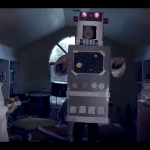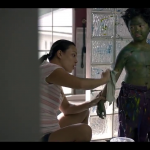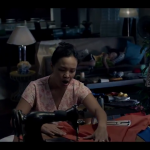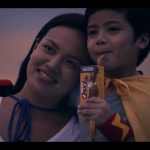Television ads that celebrate a mother’s love and sacrifice for her child are so overdone. Onthe surface, Nestle’s TV campaign for the Chuckie Buddy chocolate drink might seem like another recycled “there’s no lovelike a mother’s love” sentiment to toss onto the cliche pile. But the Chuckie Buddy TVC gives the familiar mother-and-child theme a fresh twist by slipping a heart-tugging message: Your kids are only young once. Why not join them in this fantastic experience?
Nestle’s Chuckie TVC takes us through evocative vignettes of mother and son engaged in all manner of active, imaginative play. First, they are knights slaying a fearsome dragon as they gallop away on their trusty steed. A chalk-drawn likeness of the fire-breathing mythical monster lie vanquished on the pavement. Next, a pint-sized scientist laughs triumphantly as the robot he’s built comes to life. The robot is a crude but creative contraption made from cardboard boxes and bicycle lights, held together by glue and masking tape. Then they are fearless aviators charting a course in the sky as they navigate a two-seater plane fashioned out of cardboard and electric-fan blade. At the park, Mommy Wizard commands a geyser to burst forth from the concrete depths while her son, the imperious king, beholds the towering column of water in awe.Together they read a book while lying on their stomachs on a picnic blanket. While hanging clothes out to dry, the adoring mother indulges her son who has put on the laundry basket as a helmet.
The Nestle Chuckie Buddy ad does not spare us the thankless drudgery of parenthood: the sleepless nights, the ceaseless cleaning up, and the curious glances from strangers who might question our life choices. We see the mother yawning as she puts the finishing touches on yet another set of costumes. In another scene, she is patiently washing off green coloring from her son’s body, quite possibly the aftermath of a Hulk play-acting episode. At a grocery store checkout counter, two black ninjas pay for their purchase, to the bemusement of the store cashier.
The spot’s piece de resistance is the child’s ode to his mother. Set to the music of Billy Joel’s “She’s Always a Woman,” the lyrics speak of the child’s glowing pride in having a mother who happens to be his best buddy, too. The spot culminates with mother and son, caped crusading duo, flying to the top of a hillock overlooking the city. They hold each other as they admire the setting sun cast a pale orange glow on the twilight sky. Closing the uplifting scene is the tagline: “Minsan lang sila bata. Sabayan mo na.”
Nestle Chuckie Buddy TVC doesn’t feel like it’s calculated to wring maximum emotions out of easy, soft-hearted targets. Sure, it tugs at our heartstrings. It may even leave us with a twinge of guilt. But it also rewards us this little takeaway about what it takes to create happy childhood memories and raise a child with the confidence to take on the world: a touch of creativity, a dash of imagination, and a faithful companion through life’s most magical ride.
Nestle Chuckie Buddy TVC doesn’t feel like it’s calculated to wring maximum emotions out of easy, soft-hearted targets. Sure, it tugs at our heartstrings. It may even leave us with a twinge of guilt. But it also rewards us this little takeaway about what it takes to create happy childhood memories and raise a child with the confidence to take on the world: a touch of creativity, a dash of imagination, and a faithful companion through life’s most magical ride.
I leave you now with the lyrics to the song featured in the ad. Feel free to get all choked up as you sing it softly to yourself. 

She can slay all the dragons
She’s got lasers for eyes,
She’s my ace co-pilot
when I conquer the skies;
She can cast magic spells
with the greatest of ease,
She may be my Mom
But she’s always a buddy to me.
She’s got lasers for eyes,
She’s my ace co-pilot
when I conquer the skies;
She can cast magic spells
with the greatest of ease,
She may be my Mom
But she’s always a buddy to me.
She’s my captain, my hero
She’s as strong as can be,
She may be my Mommy
But she’s always a buddy to me.
Watch this link before you proceed reading :)She’s as strong as can be,
She may be my Mommy
But she’s always a buddy to me.
"https://www.youtube.com/watch?v=qmdEQ6eW39s"
The Chuckie commercial is about a bonding of a mom and her son. Based on the commercial, the son described that his mom used to play with him like she can do anything. She can be a soldier, a a pilot and even a magician whom every mom can really do just to make her child/children feel the happiness and love.
Structuralist view literature as a system of signs. They try to make plain the organizational codes that they believe regulate all literature. Structuralism is a way of thinking about the world. At it's simplest, structuralism claims that the very nature of every elements in any given situation has no significance by itself, and is determined by the other elements involved in that situation. The full significance of any entity cannot be perceived unless and until it is integrated into the structure of which it forms a part. Story's meaning develops from it's overall structure rather than from each individual story's isolated theme.
In the commercial the experiences of the son and of the mother is taken as one to create a meaning-- a desired meaning. They are combined to generate the desired theme/ message of the TVC. The commercial has the message appointing to parents that they must have time and effort to bond with their children. They have the tagline that says "Minsan lang sila bata, sabayan mo na" which means a child grows fast and every single moment should not be wasted and should be treasured.
What makes the commercial really attractive is its jingle. and the thought of it. Its jingle has a nice tune and lyrics that can be easily memorized, can be sang by anyone who could hear it. The commercial attacks the emotional aspect of people. They can get their audience by the heart because it connects to anyone's heart. The video and the song is more than enough to convey what the commercial wants to convey. It doesn't have too many words, just the lyrics. It doesn't have animations or whatsoever, just the video and the tagline. It doesn't involve famous actors or actresses, just a typical mom and son. Very simple yet very expressive. :)
Reference:
http://myteachermommy.com/2015/08/04/when-parenting-becomes-childs-play-nestle-chuckie-buddy-tvc/
https://www.youtube.com/watch?v=qmdEQ6eW39s











